calsfoundation@cals.org
Vilonia (Faulkner County)
| Latitude and Longitude: | 35°05’02″N 092°12’29″W |
| Elevation: | 569 feet |
| Area: | 7.97 square miles (2020 Census) |
| Population: | 4,288 (2020 Census) |
| Incorporation Date: | August 23, 1938 |
Historical Population as per the U.S. Census:
|
1810 |
1820 |
1830 |
1840 |
1850 |
1860 |
1870 |
1880 |
1890 |
1900 |
|
– |
– |
– |
– |
– |
– |
– |
– |
– |
– |
|
1910 |
1920 |
1930 |
1940 |
1950 |
1960 |
1970 |
1980 |
1990 |
2000 |
|
– |
– |
– |
259 |
215 |
234 |
423 |
736 |
1,133 |
2,106 |
|
2010 |
2020 |
|
|
|
|
|
|
|
|
|
3,815 |
4,288 |
Vilonia of Faulkner County was originally known as Vilsonia, the “land of two valleys,” by the pioneers who settled the valleys near the forks of Cypress Creek in the early 1860s. The name was given to the community by members of Masonic Lodge No. 324, which was established early in the town’s history. Members of this lodge originally hailed from North Carolina, Mississippi, and Tennessee and came to the area now known as Vilonia in search of fertile land. When they applied for a post office, the approval came back misspelled Vilonia, but they let it stand. Vilonia is located thirteen miles east of Conway (Faulkner County) on U.S. Highway 64.
After the Civil War, families of English, Irish, German, and Scottish descent searched for fertile land to grow cotton, grains, vegetables, and fruits and moved into the settlement. Among the first to arrive was the family of Mary Downs (a Confederate soldier’s widow) from Mississippi with five daughters and a son, William James Downs. He was later the father of Dr. Joseph Henry Downs, who practiced medicine in Vilonia for fifty-four years and served on the school board for fifty years. Dr. Jessie B. Munn, uncle of Downs, came from North Carolina. Munn contributed to the community as a physician and a school leader.
Businesses were established to serve the farmers. George W. Harris erected a cotton gin powered by steam and a gristmill to grind corn into meal. Oscar Simpson owned the first drugstore. R. B. Evans was Vilonia’s dentist, and one Mr. Davis was the town’s miller. A Dr. Carr served as the community’s first medical doctor. The 1870s saw the emergence of the first mercantile businesses in town.
The first school was established in 1874. It was a private school, taught by William T. Suttle, on the ground floor of a log cabin used by the Masons. It became a public school in 1880.
In 1895, a white man named Albert England was lynched after being arrested for burglary.
In 1899, Noah Simpson and Reverend W. F. Dallas organized the Arkansas Holiness College, known originally as the Holiness Academy. It operated until 1931, when it consolidated with the Nazarene College in Bethany, Oklahoma, where it was relocated. Baptist, Methodist, and Nazarene churches were established in the community by 1900.
About 1900, a two-story frame school building was built on the north campus of the public school. In 1928, Fred Monroe Bollen became its superintendent. Not long before, a brick school building was built on the school’s main campus. All twelve grades were taught, and the school consistently won high points in countywide academic competitions.
Vilonia was incorporated on August 23, 1938, with Thomas Henry Hill as mayor.
The Great Depression, which drastically lowered the price of cotton, combined with several drought seasons greatly impacted Vilonia, as approximately eighty to ninety percent of the residents were cotton farmers. However, the population of Vilonia managed to remain steady, given the self-employed nature of farm work and the lack of jobs elsewhere.
On January 8, 1942, the brick school building burned. Classes finished the term in other buildings. One month into World War II, all resources were going to the war effort. But Vilonia citizens donated labor, money, and materials to rebuild the school. The new building was finished by the next school year. By this time, many Vilonia citizens had found employment at the Arkansas Ordnance Plant in Jacksonville (Pulaski County), which operated three daily shifts. Buses, which were granted extra gasoline during this time of rationing, transported workers to the plant for two of the three shifts.
Modern-day Vilonia has a city hall, a fire department, a police department, a park director, a city court clerk, banks, restaurants, stores, and other services. The fire department hosts Fall Fest at Halloween for the children; it includes a free carnival with games, candy, and prizes.
There is no industry in Vilonia and only minimal agriculture; most citizens now travel to the nearby cities of Conway and Little Rock (Pulaski County) for employment. However, Vilonia still boasts a noted educational system, and the school continues to be the center of the community. In 1997, its elementary school was chosen by Redbook magazine as one of the 177 outstanding schools in the nation.
On April 25, 2011, a tornado swept through Vilonia, killing five people and damaging structures. Another tornado on April 27, 2014, killed eight people, flattened homes and businesses, and destroyed the new Vilonia Intermediate School, which had been set to open in the fall. In response to the latter disaster, President Barack Obama conducted his first official visit to the state in order to survey the damage and visit with Vilonia residents on May 7, 2014.
Vilonia’s Museum of Veterans and Military History, located downtown, was damaged in the tornado. It opened in a new building on N. Mount Olive Road on April 25, 2015.
For additional information:
Faulkner County Historical Society. Faulkner: Its Land and Its People. Conway, AR: River Road Press, 1986.
Milburn, Mr. and Mrs. Charles. “Vilonia–A Short Sketch.” Faulkner Facts and Fiddlings 10 (Spring 1968): 3–10.
Trimble, Betty Owen. The Path from the Cellar. Raleigh, NC: Pentland Press, 2001.
Trower, Kathy. “Vilonia ‘Land of Two Valleys’ Gets Spelling from Typographical Error.” Log Cabin Democrat. March 10, 2000.
Betty Owen Trimble
McKinney, Texas
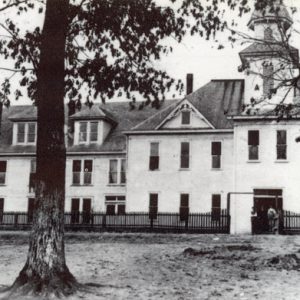 Arkansas Holiness College
Arkansas Holiness College  Faulkner County Map
Faulkner County Map  Obama's Helicopter
Obama's Helicopter 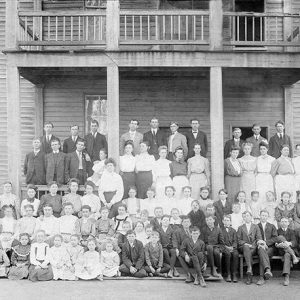 Vilonia School
Vilonia School 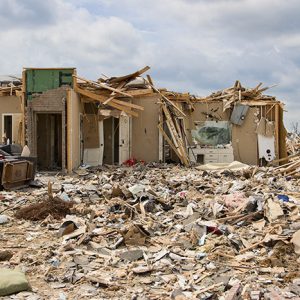 Vilonia Tornado Damage, 2014
Vilonia Tornado Damage, 2014 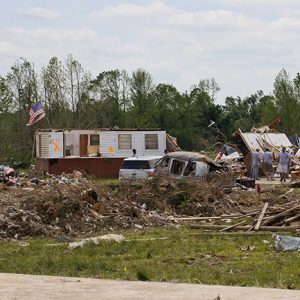 Vilonia Tornado Damage, 2014
Vilonia Tornado Damage, 2014 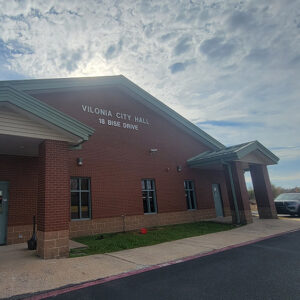 Vilonia City Hall
Vilonia City Hall 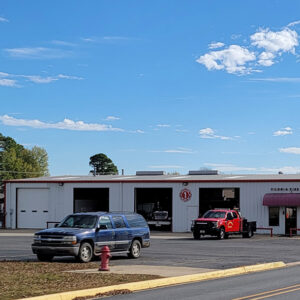 Vilonia Fire Department
Vilonia Fire Department 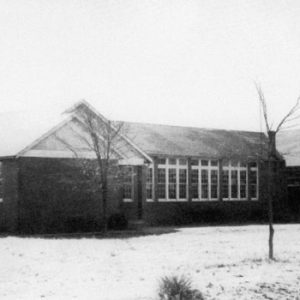 Vilonia High School
Vilonia High School  Vilonia Library
Vilonia Library 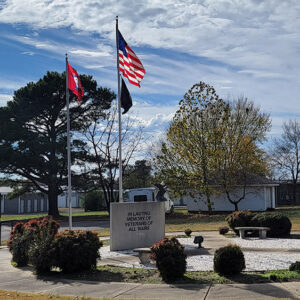 Vilonia Veterans Memorial
Vilonia Veterans Memorial 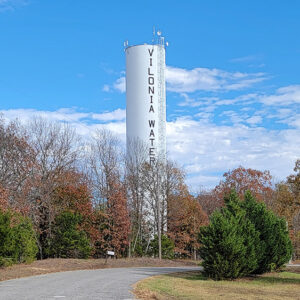 Vilonia Water Tower
Vilonia Water Tower 




(2017) My ninety-six-year-old mother played on the 1935 Vilonia girls’ basketball team. There was a cow’s head on the front of the jersey, but I don’t know what the mascot was.
Your entry for Vilonia mentions a framed two-story school building built circa 1900.
The first principal of this school was Thomas Floyd Forrest, my grandfather. Moreover, he was the first examiner of Faulkner County. (To be a teacher, a person was examined, quizzed, and interviewed, in Faulkner County, he was the initial examiner.)
In the photo I have, he in the third row, on the far left, and is holding his first-born child, a daughter named Mabel Forrest. [Editor’s note: see attached photo of school on the right-hand side of the entry page.] I dated the photo based on her approximate age (she was born in March 1904). I surmise the photo was taken in the fall of 1904. A sister-in-law, Prudence (Peggy) Downs, is standing next to him. Alice Daughtry (Daughtery?) was the other teacher (T. F. Forrest did double-duty, both teaching and serving as principal). Alice is seen standing in front of the left-center pillar/post on the top-most step, her hands clasped in front of her.
Thomas Floyd Forrest married Mary Lillia Downs, who was named after her grandmother, a lady mentioned in the Vilonia piece who arrived in Vilonia from Mississippi.
Mary Downs is also mentioned; she is the grandmother of Mary Lillia Downs. Mary Downs’s maiden name was Munn.
I am the grandson of Thomas Floyd and Mary Lillia Downs Forrest.